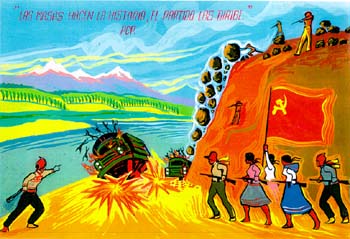massline.info
The Mass Line in Peru

"The masses create history, the Party leads."

The main Maoist party in Peru calls itself the Communist Party of Peru. Since this name is also used by other Peruvian "leftist" groups, the Maoists have most often been referred to popularly as Sendero Luminoso [Shining Path]. But here I will use their official name, which is abbreviated as PCP (from the Spanish initials). The founder of this party is Abimael Guzmán Reynoso, who led it under the name of Chairman Gonzalo until his capture by the government in 1992. Since then he has been held in a military prison.
The PCP initiated a people's war in 1980, which gained strength throughout the decade and into the first few years of the 1990s. But with Guzmán's capture, the revolution suffered an abrupt collapse. More than a decade later it is still attempting to recover, though it has been showing some signs of a resurgence lately.
To my knowledge, the reasons for the collapse of this first attempt at revolution in Peru have not yet been publicly summed up by either the PCP or by any organized forces of the international revolutionary movement. It seems that one of the clear factors has to be the excessive reliance the party placed on Chairman Gonzalo as an individual. There was a tremendous cult of personality built up around him, even though the PCP had not even achieved state power yet. The PCP called Gonzalo the "fourth sword of Marxism" (the previous three being, presumably, Marx, Lenin and Mao), and described him as the "guarantor of the revolution." In reality no single individual can "guarantee" the success of any revolution, as events in Peru have proven once again.
Another suggested reason for the collapse of the first revolutionary attempt in Peru is the possible neglect of mass line methods and an insufficient focus during the Guzmán period on the struggles the masses themselves considered most important. I don't know if this suggestion is correct or not. It is very difficult to know the extent to which the mass line, as I understand the term, was (or is) being used by the PCP. The party did use the term 'mass line', but it seems to have been used in a broad way, as meaning something like working among the masses or the Party work of organizing the masses in support of the people's war. Much emphasis was put on a basic principle of historical materialism, that "the masses make history", and little attention, as far as I have been able to determine, was placed on leading the masses according to Mao's principle of "from the masses, to the masses".
Some time after Guzmán's capture, a major two-line struggle developed within the PCP ["Shining Path"], and the two factions may now be operating as independent parties. It is difficult to know the precise positions of either side in this struggle—let alone which side is most correct. But it seems that one faction is still led by Guzmán from prison and has been calling for negotiations with the government and the end (at least for now) of the guerrilla war. The other, apparently smaller, faction is still engaged in people's war. It has, however, criticized some of the past practice of the PCP in relation to the masses. I don't know if this includes the criticism that the Party was not paying sufficient attention to the mass line.
—Scott H.
"The Mass Line", a document from the PCP [1988]. This document mentions the leadership method of "from the masses, to the masses" only in passing, but does discuss the PCP's efforts to mobilize various sections of the masses. One position defended here, that "all the mass work" of the Party should be "done through the People's Guerrilla Army" is rather dubious, in my opinion, and sounds like a reflection of what Mao called "a purely military point of view." It is doubtful that the PCP fully followed such a policy, however. It would have been very difficult to implement it in Lima and other urban areas, for example.
A friend of mine who speaks Spanish tells me that the frequently used word 'revindication' in this translation might be somewhat misleading. He gave me this explanation: The Spanish word 'reivindicación' means 'recovery' (of something you have a right to). However, in Spanish-speaking countries in the Americas the left often uses the term to mean struggles around the basic welfare of the masses in general. Literally, the word means to regain lost positions, such as if welfare were cut or land taken away, a 'lucha reivindicativa' would be a struggle to get back the previous position of things. It is often expanded (though probably somewhat differently in different geographical areas) to include all sorts of reformist struggles. It might be best translated as 'reformist struggle' rather than 'revindication struggle', although that doesn't quite mean "reformist" in our typical sense of the word. (After all, Spanish also has the word 'reformista', which is used to connote struggles that have an actual reformist aim, whereas revolutionaries might engage in 'lucha reivindicativa'.)
[More may be added later.]